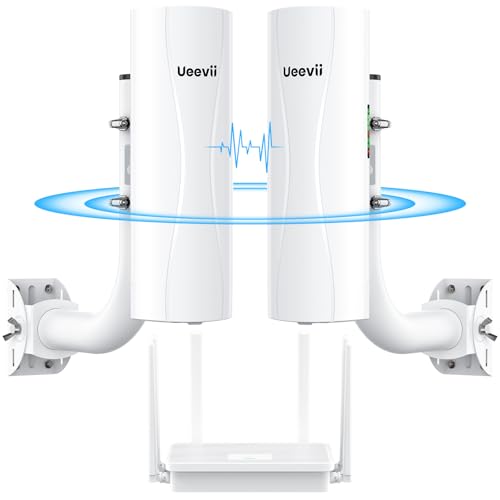We’ve all been there. It’s a perfect summer afternoon, the barbecue is sizzling, and you decide to stream your favourite playlist, only to be met with the dreaded buffering wheel. Or perhaps you’ve finally set up that dream garden office in the shed, but the Wi-Fi signal is so weak and unreliable that a simple video call becomes an exercise in frustration. For years, I battled with a patchwork of Wi-Fi extenders and repeaters that promised the world but delivered a choppy, inconsistent connection that barely reached the patio, let alone the far corners of the garden. This digital boundary can feel incredibly restrictive, turning our valuable outdoor spaces into connectivity dead zones. The inability to work, stream, or even browse effectively outdoors is more than an inconvenience; it’s a barrier to fully enjoying our homes.
- Durable, weatherproof enclosure for outdoor Wi-Fi applications
- Up to 1200Mbps with 2×2 MIMO technology
What to Consider Before Buying an Outdoor Wireless Access Point
An Outdoor Wireless Access Point is more than just a gadget; it’s a key solution for liberating your internet connection from the confines of your home’s walls. Unlike a standard Wi-Fi repeater, which simply picks up a weak signal and rebroadcasts it (often at half the speed), a dedicated access point (AP) is hardwired directly to your router via an Ethernet cable. This creates a brand new, powerful, and stable Wi-Fi hub right where you need it most—outdoors. The main benefit is a dramatic increase in both signal strength and speed, allowing you to blanket your garden, patio, workshop, or pool area with the same high-performance Wi-Fi you expect indoors.
The ideal customer for this type of product is someone facing the exact challenges we described: homeowners with medium to large gardens, people who have converted a shed or outbuilding into a home office, or even small businesses like cafes and pubs wanting to offer reliable Wi-Fi to customers in their outdoor seating areas. If you’ve tried extenders and found them lacking, an outdoor AP is the logical next step. However, it might not be suitable for those who live in apartments without outdoor space or for individuals who are unable or unwilling to run an Ethernet cable from their router to an outside wall. For those seeking a simpler, albeit less powerful, solution, a high-quality mesh Wi-Fi system with an indoor satellite placed near a window might suffice, but it will never match the raw performance of a dedicated, wired outdoor AP like the TP-Link EAP225-Outdoor AC1200 Access Point.
Before investing, consider these crucial points in detail:
- Dimensions & Space: Consider where you will mount the device for optimal coverage. The TP-Link EAP225-Outdoor is designed to be relatively discreet but needs to be placed on a wall or pole. Think about the cable route from your router and the aesthetic impact on your property. Its slim profile and white colour help it blend in with most exteriors.
- Capacity/Performance: Don’t just look at the top speed. The AC1200 rating means the TP-Link EAP225-Outdoor AC1200 Access Point delivers combined speeds of up to 1200 Mbps across its dual 2.4 GHz and 5 GHz bands. More importantly, it features a Gigabit Ethernet port to ensure the wired connection isn’t a bottleneck, and MU-MIMO technology allows it to communicate with multiple devices simultaneously, which is crucial for busy outdoor areas.
- Materials & Durability: This is non-negotiable for an outdoor device. The EAP225-Outdoor features a robust, IP65-rated weatherproof enclosure. This certification means it is completely dust-tight and protected against low-pressure water jets from any direction, making it perfectly suited to withstand rain, wind, and varying temperatures without failing.
- Ease of Use & Maintenance: The inclusion of Power over Ethernet (PoE) is a game-changer. It means you only need to run a single Ethernet cable to the unit, which will carry both data and power, simplifying installation immensely. Furthermore, management through the free Omada Controller software allows for easy setup, monitoring, and future firmware updates, ensuring the device remains secure and performs optimally over the long term.
Choosing the right access point transforms your outdoor space. It’s about creating a seamless extension of your digital life, ensuring you’re connected wherever you are on your property.
While the TP-Link EAP225-Outdoor AC1200 Access Point is an excellent choice, it’s always wise to see how it stacks up against the competition. For a broader look at all the top models, we highly recommend checking out our complete, in-depth guide:
- 300 Mbps wireless speed ideal for smooth HD video voice streaming and online gaming
- BE3600 Dual-Band Wi-Fi 7 (2882 Mbps on 5 GHz + 688 Mbps on 2.4 GHz)
First Impressions: Built to Brave the Elements
Unboxing the TP-Link EAP225-Outdoor AC1200 Access Point, the first thing we noticed was its solid, confidence-inspiring build quality. It’s larger and more substantial than the pictures might suggest, feeling less like a consumer gadget and more like a piece of professional networking equipment. The matte white plastic casing is thick and durable, and the seals around the casing and the weatherproof grommet for the Ethernet port leave no doubt about its ability to handle the outdoors. The two detachable omnidirectional antennas feel robust and click securely into place. A significant advantage we immediately appreciated, and one echoed by many users, is the inclusion of a PoE adapter in the box. Many competing brands, particularly in the prosumer space, sell this essential component separately, so its inclusion here adds considerable value and means you have everything you need to get powered up straight away. The package also contains mounting kits for both wall and pole installations, offering excellent flexibility for placement. It was clear from the start that TP-Link has designed a comprehensive, all-in-one package for extending Wi-Fi outdoors. You can see its full feature set and included accessories online.
Advantages
- Exceptional long-range Wi-Fi coverage
- Robust and durable IP65 weatherproof design
- Simple setup and management via the free Omada Controller software
- PoE adapter and mounting kits are included in the box
- Excellent value for money compared to competitors
Limitations
- Requires a physical Ethernet cable run from your router
- Coverage can be affected by physical obstructions like thick walls
A Deep Dive into the TP-Link EAP225-Outdoor’s Performance
An outdoor access point lives or dies by its real-world performance. It’s not about theoretical maximum speeds in a lab but about delivering a stable, fast connection at the bottom of the garden on a busy Saturday. We put the TP-Link EAP225-Outdoor AC1200 Access Point through its paces to see if it lives up to its promises, and frankly, we were incredibly impressed.
Installation and Setup: From Box to Blazing Speeds
For many, the thought of installing networking hardware is daunting, but TP-Link has streamlined the process remarkably well. The physical installation is the most labour-intensive part, but it’s straightforward. We chose a spot on the rear wall of the house, just under the eaves for some extra protection. Using the supplied bracket and a couple of screws, the unit was securely mounted in minutes. The real genius here is Power over Ethernet (PoE). We ran a single outdoor-rated Cat6 Ethernet cable from our indoor router, through the wall, and to the access point. Inside, we connected this cable to the included PoE injector, which then plugs into the mains power and has a second port to connect to our router. This single-cable solution is elegant and eliminates the need for a qualified electrician to install an outdoor power socket.
Once powered on, the software setup was even easier. We downloaded the free TP-Link Omada app to a smartphone. The app quickly discovered the new access point on the network. We adopted it into our new “network,” gave our outdoor Wi-Fi a name (SSID) and a strong password, and that was it. The entire software configuration took, as one user accurately noted, “5 minutes to set up.” For more advanced users, the Omada Controller software can be installed on a PC or a dedicated hardware controller for deeper configuration, including setting up guest networks, captive portals, and managing multiple access points seamlessly. But for a simple, powerful outdoor Wi-Fi extension, the mobile app is more than sufficient. The simplicity of this whole process is a feature that truly sets it apart for home users.
Real-World Coverage and Signal Strength
This is where the TP-Link EAP225-Outdoor AC1200 Access Point truly shines. Our test garden is approximately 35 metres deep, with a wooden workshop at the far end that previously had zero usable Wi-Fi. After installation, the results were transformative. Standing on the patio, about 5 metres from the AP, we clocked download speeds on the 5GHz band that were virtually identical to being stood next to our indoor router. This was confirmed by one user who exclaimed, “My WiFi speed is faster then indoors.”
Walking towards the middle of the garden, around 20 metres out, the 5GHz signal remained strong, delivering well over 250Mbps on our 500Mbps connection—more than enough for 4K streaming or large file transfers. This aligns perfectly with another user’s experience of getting a “steady 300mbps+” in a previous dead spot. At the workshop, 35 metres away, the 5GHz signal was weaker but still usable, while the 2.4GHz band provided a rock-solid, stable connection perfect for web browsing, emails, and streaming music. This ability to conquer challenging environments was a common theme in feedback, with one user successfully getting a strong signal to stables 45m away, and another finally getting Wi-Fi into their “Faraday Cage” iron brick house. While one user reported the signal dropping off around 50 metres, this is a respectable range for a device in this price bracket and provides a realistic expectation of its impressive capabilities.
The Power of Omada: Centralised Management and Mesh
While the EAP225-Outdoor works brilliantly as a standalone device, its true power is unlocked when you see it as part of the broader TP-Link Omada ecosystem. This Software-Defined Networking (SDN) platform allows for the centralised management of multiple access points, switches, and routers, all from a single interface. For a home user, this might mean adding an indoor Omada access point later and managing both from the same app, ensuring seamless roaming. Seamless roaming allows your phone, tablet, or laptop to automatically switch to the access point with the strongest signal as you move between the house and garden, without any interruption to your connection—no more manually switching Wi-Fi networks.
For small businesses or users with larger properties, the Omada Mesh technology is a killer feature. If you have an area where running an Ethernet cable is impossible, you can place another Omada AP (like a second EAP225-Outdoor) within the wireless range of the first one. The second unit will then connect to the first one wirelessly, extending the network even further without needing its own wired connection. This flexibility makes scaling your network incredibly easy and cost-effective. The Omada platform elevates the TP-Link EAP225-Outdoor AC1200 Access Point from a simple Wi-Fi extender to a professional-grade networking tool available at a consumer-friendly price.
What Other Users Are Saying
The sentiment surrounding the TP-Link EAP225-Outdoor AC1200 Access Point is overwhelmingly positive, confirming our own excellent experience. Many users highlight the sheer simplicity of the setup process. One happy customer noted, “Hard wired with a 30m cat 6 cable to indoor router… 1h to hardwire and 5 minutes to set up.” Another praised its problem-solving ability, stating it was the perfect solution for getting internet into a “new garden room” after finding other options too expensive or complex.
The performance and range are consistently applauded. We saw numerous comments like, “Good Signal strength covers all my garden which is 200 foot long and most of the house,” and, “What a winner, I’ve now got great 2.4 and 5 GHz WiFi access in my garden and workshop.” However, feedback isn’t universally perfect. One user found the coverage less than they expected, saying it “loses signal about 50 metres away,” which serves as a good reminder that while performance is excellent, it’s not infinite and depends on environmental factors. Another user reported their unit was “Absolutely useless,” which, given the widespread praise, likely points to a defective unit or a complex network conflict rather than a flaw in the product’s design, highlighting the importance of purchasing from a reputable source with a solid return policy.
How Does the TP-Link EAP225-Outdoor Compare to the Alternatives?
While the EAP225-Outdoor is a fantastic all-rounder, specific needs might call for a different solution. Here’s how it stacks up against three notable competitors.
1. UeeVii AX3000 Wireless Bridge System 5km
- Complete wireless bridge kit: includes two 5.8G wireless bridges, adjustable installation brackets and an AX3000 high-speed WiFi router with dual band: all-in-one solution for network expansion and...
- 5 km point-to-point transmission: Wireless bridges support transmission over long distances up to 5 kilometres and ensure stable data transmission for surveillance systems, remote offices or...
The UeeVii AX3000 isn’t a direct competitor but serves a different, more specific purpose. This is a point-to-point wireless bridge system designed to beam an internet connection over vast distances (up to 5km). If your goal is to get internet from your main house to a separate building hundreds of metres or even kilometres away, this is the tool for the job. However, it’s not designed for general 360-degree coverage in a garden. You would use this to connect two buildings, and then potentially install an access point like the EAP225-Outdoor at the remote location. It’s overkill and ill-suited for simply covering a back garden.
2. Ubiquiti U6-PRO
The Ubiquiti U6-PRO is a step up in terms of technology and performance. It supports the newer Wi-Fi 6 (802.11ax) standard, offering higher theoretical speeds and better efficiency in environments with many connected devices. It’s an excellent choice for tech enthusiasts, prosumers, or businesses who need the absolute best performance and want to future-proof their network. However, it comes at a higher price point and is part of the competing Ubiquiti UniFi ecosystem, which some find has a steeper learning curve than TP-Link’s Omada. For most home users simply wanting great garden Wi-Fi, the performance gains of Wi-Fi 6 outdoors might not justify the extra cost over the EAP225-Outdoor.
3. Ubiquiti UAP-AC-PRO Access Point
The Ubiquiti UAP-AC-PRO is a classic and direct competitor to the TP-Link EAP225-Outdoor. It’s a highly respected, robust, and weather-resistant access point that has been a go-to for installers for years. It offers comparable AC-class performance and is known for its rock-solid reliability within the UniFi ecosystem. The main deciding factors often come down to price and ecosystem preference. The TP-Link EAP225-Outdoor AC1200 Access Point is typically more affordable, includes the PoE injector, and its Omada software is often considered more user-friendly for those new to managed networks. The UAP-AC-PRO is a superb product, but the TP-Link model often presents a better overall value proposition for the home user. You can check the latest price and compare directly.
Our Final Verdict: Is the TP-Link EAP225-Outdoor Worth It?
After extensive testing and analysis, our conclusion is a resounding yes. The TP-Link EAP225-Outdoor AC1200 Access Point is an outstanding product that offers the perfect blend of performance, durability, ease of use, and value. It definitively solves the common and frustrating problem of weak or non-existent outdoor Wi-Fi, transforming gardens and outbuildings into fully connected spaces. The inclusion of a PoE injector and versatile mounting hardware makes it a complete, out-of-the-box solution that punches well above its price tag. While it does require running an Ethernet cable, the resulting stability and speed are far superior to any wireless repeater or extender.
We recommend it without hesitation to any homeowner looking to extend their network outdoors, whether for working from a garden office, streaming movies on the patio, or simply browsing by the flowerbeds. It is, quite simply, one of the best and most cost-effective upgrades you can make to your home network. If you’re tired of being tethered to your indoor router and want to unlock the full potential of your outdoor space, we highly recommend you invest in the TP-Link EAP225-Outdoor today.
Last update on 2025-11-11 / Affiliate links / Images from Amazon Product Advertising API







